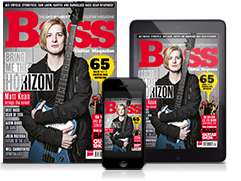Jamiroquai's Paul Turner: “You need to be able to head-nod or foot-stomp while you’re playing, or you’re not in the pocket”
Going deeper with the groove-orientated bassist and session supremo
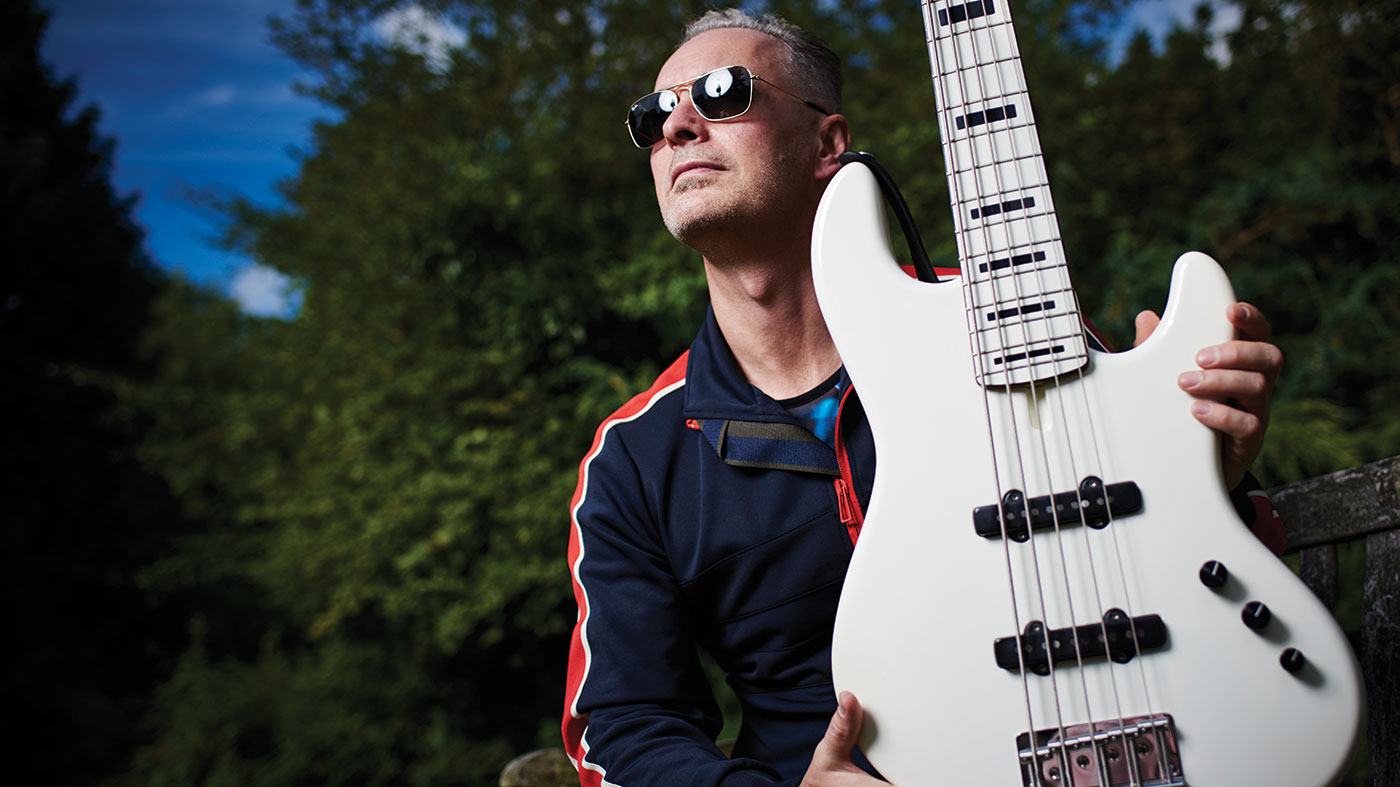
Name a British band with as much commercial presence at arena, festival and stadium level as Jamiroquai. Coldplay? Relative new boys. Iron Maiden? Definitely, but that’s a completely different market sector.
Adele? Sure, but she’s a singer, rather than a band band, if you see what we mean. After that, you’re struggling; of the acid jazz generation of the early 90s, singer Jay Kay and his crew occupy a huge niche of their own, having recently headlined the Coachella festival and delivered a full UK arena tour.
It’s a good time for us. Quite a few people have recently referred to Jamiroquai as an influence
Holding down the incredibly funky low end in Jamiroquai, alongside Kay plus Rob Harris (guitar), Matt Johnson and Nate Williams (keyboards), Sola Akingbola (percussion) and Derrick McKenzie (drums), Paul Turner is something of a hero in the Brit bass community, and for good reason. The man’s work ethic is unparalleled; he was gigging six nights a week at the age of 15 and has racked up sessions with over 70 artists since then.
Turner’s CV was impressive even before he joined Jamiroquai in 2005, having played world tours with Take That and Annie Lennox, as well as innumerable live and televised sessions with Ruby Turner, Errol Brown, Edwin Starr and many more artists from the pop and soul world.
Tina Turner, Bryan Ferry, George Michael and other household names have all utilised his skills at the low end, and that’s before we come to his side projects, Brother Strut, Trioniq, Groovesonix, and the Dark Sinatras, plus a recurring gig with Sister Sledge.
You get the picture. In our world, you don’t get bigger than Turner, and when we talked to him over a rather nice pub lunch recently, he had a lot to tell us about the current state of the bass nation. Read on…
Jamiroquai’s new album, Automaton, did great when it came out last year.
Want all the hottest music and gear news, reviews, deals, features and more, direct to your inbox? Sign up here.
“It did. It did very well in the iTunes chart in its first month of release, and it’s done really well in America, even though we haven’t played there since 2005. It’s a good time for us. Quite a few people in the film and music industries have recently referred to Jamiroquai as an influence - people like Pharrell Williams, Mark Ronson and so on - so that’s given us a boost.”
When you record bass with Jamiroquai, who’s in the studio with you?
Jay doesn’t want perfection; he wants vibe and spirit
“Matt and Jay are in there with me when I record my parts. Usually Jay will say ‘You know the kind of thing to do on this song’ and let me get on with it, but sometimes Matt will play an idea for a bassline, or Jay might hum something to me. There’s never any cut-and-paste moments on a Jamiroquai album; you get that more and more on some modern recordings.
“Other bands’ producers might say, ‘Can you give me three passes on this line?’ and when you leave, you won’t necessarily know which pass, or even which parts of a pass, will be used. I don’t really like that process, and fortunately with Jay it’s a case of the bass being clearly played. The lines need to build and have some momentum. He doesn’t want perfection; he wants vibe and spirit, and for it to be audible that I’ve played the track from the beginning to the end.”
You’ve recently played major shows in the USA and elsewhere. Sum up the live experience for us.
“We all get a buzz out of it because we never work to setlists. It’s not uncommon for us to play music on stage that we haven’t recorded. There’s very few Jamiroquai songs that we haven’t played; we’re able to play them at the drop of a hat. It’s great, and I really enjoy it. Jay likes everyone to be flying by the seat of their pants.”
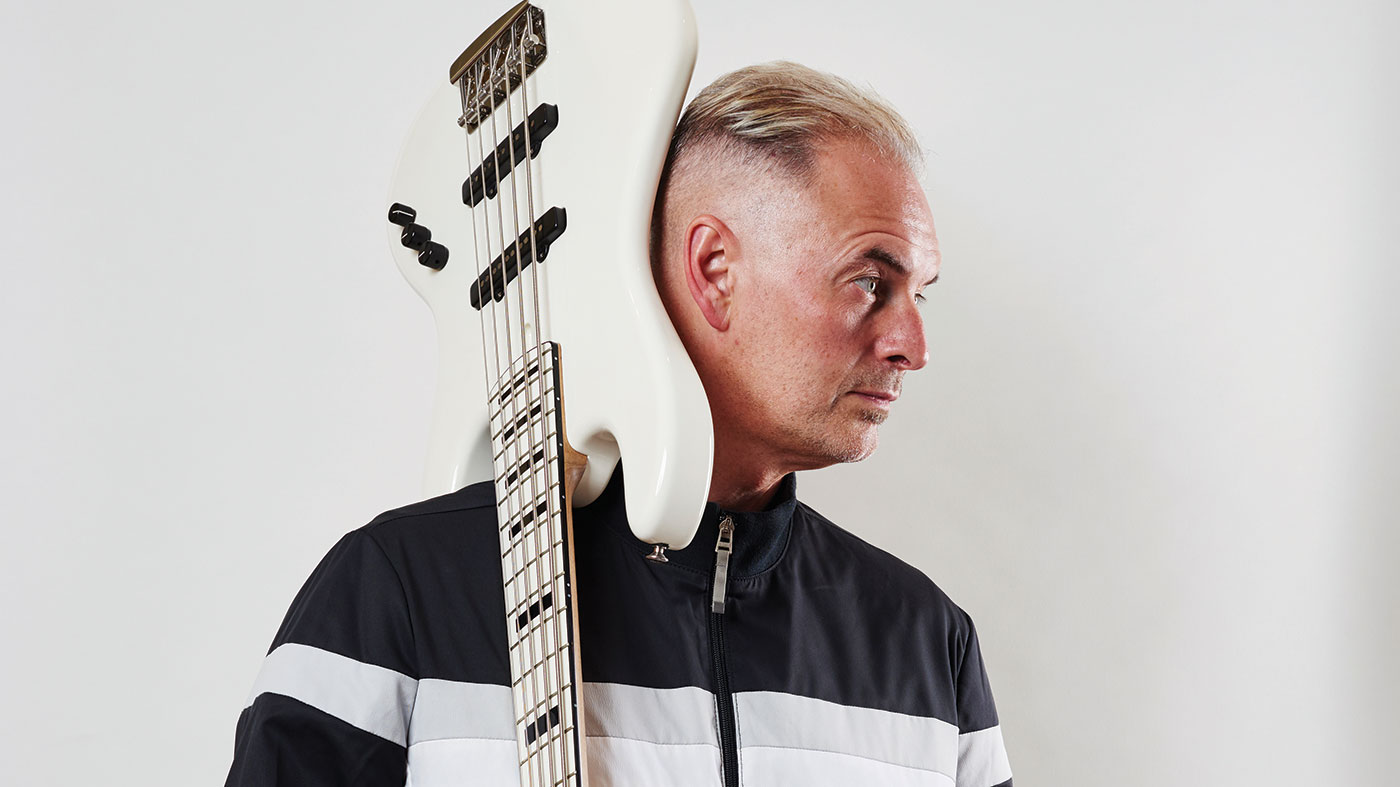
Stenback again
Are you mostly using Stenback basses these days?
“Yes - my beloved '60s Fender Jazz stayed at home last summer! I’ve used it on a couple of recent recording sessions, but even on those sessions I’ve still used my two Stenback five-strings. They’re stunning; I call the white one Larry and the black one Bootsy. They respond so dynamically. As passive instruments, there’s none of the inherent compression that you get with an active preamp, and they’re very punchy and lively. They feel like a real, classic bass.”
Are you equally happy with four- and five-string instruments?
I’m on record as stating that a five-string can’t sound as good as a four-string, but I’ve had to eat my words
“I’m on record as stating that a five-string can’t sound as good as a four-string, but I’ve had to eat my words. It always used to annoy me when luthiers and reviewers said that with a five, it’s all about the B string. It’s not. Because of the range of a five-string, the luthier usually has to make a compromise with the upper end of the range, which sounds thin. I like the top-end to sound like a P-Bass. I don’t have that problem with the Stenbacks - they do it all. They’re pretty much off the shelf, but there are a few different things that [luthier] Tom Stenback has done to the bodies of mine to make them resonate in the way that my 1966 Jazz does.”
What are the Stenbacks’ specs?
“Larry is alder and Bootsy is ash. I’ve got a 1977 Jazz with an ash body, and it’s a great sound, but not the kind of sound that I’ve used for the last 10 years or so. I never thought I’d play an ash body again, because I thought you needed a more throaty wood with a five-string, but Tom’s got a great knack for marrying a neck with a body. The necks and fingerboards are both maple; the boards have black and white lacquers. I initially asked for one with a rosewood fingerboard, but the maple sounded better. My fives also have the same 20mm spacing as a four-string.”
How about the electronics?
I’m really into messing about with effects; I’ve got so many ways of blending them
“The pickups also differ between the two instruments; the black one has Lundgren switchable pickups, so each of them can be single, parallel and series. The controls on both basses are volume, volume, tone, but the black bass has an extra knob on it, which a few people have assumed is an active preamp, but it’s actually a volume blend for a Roland MIDI pickup.”
Which other gear do you have?
“I have a fretless Music Man Stingray, which I used on the song Automaton; I was trying to get the sound of Imagination’s Just An Illusion bassline. It takes the edge off the note a little bit. I’ve also got an Alleva Coppolo, a Fodera NYC, an AV and a Moollon. These days I tend to take a Precision, a Jazz, a Stenback and maybe a Hofner Club or a Mustang to the studio; I used the Mustang on the new Lighthouse Family album.”
There are tons of cool filter and synth sounds in your catalogue.
“I’m really into messing about with effects; I’ve got so many ways of blending them. I’ve got three vintage Mu-Trons, but I’ve put them to bed because I’ve discovered Wonderlove pedals. Like the Stenbacks, they’re a way of getting a sound which is on a level with older gear, but with a bit more reliability and variability. I use a 3Leaf Doom pedal too, which is a beautiful, warm fuzz.”
Always Aguilar
Do you record through amps in the studio?
“I’ve used an Aguilar Tone Hammer as a DI before, but for this album I used a Jule Monique Dovecage tube amp on all but one track, Hot Property. On that one, we went straight into a Neve preamp for a really quick transient, although the Monique sounds fantastic on its own. I’ve also got a 1966 Ampeg B15, which I take to studios every now and then.”
You’re a long-time Aguilar endorser. What keeps you coming back?
I’ve used nothing but Aguilar for my live backline since 2004. They’re still the brand that works best for me
“I’ve used nothing but Aguilar for my live backline since 2004. They’re still the brand that works best for me. I want to know that I can get what I need from my gear - anything else is a distraction. Some players will change their amp or instrument every year, and be convinced each time that they’ve found the ultimate one, but that’s not me. For me, Aguilar gear are like modern classics, almost like a souped-up version of an Ampeg.”
Run us through your EQ.
“People often ask me how I get my tone, and the answer is that I have everything pretty flat, apart from a bit of a bass bump. The basses are passive; on my Jazz-style basses I usually have the tone at 80 percent, unless I’m doing a Jaco impression, and I do the rest with the pickups and my hands. I often record on a ’63 Precision with flats. I like funky, dead strings; I travel with a few packs of new and used Dunlop Super Bright Nickels.”
So what Aguilar gear do you use live?
“With Jay, I use a DB751 amp; last year I also tried the new AG700, which is absolutely phenomenal. It more than handled the huge Jamiroquai stage. It’s become the amp that I carry around myself for club dates, so I keep the 751 for the tour. The Tone Hammer 500 is my backup amp, although it’s never needed.
“For cabs, I’ve been through most of the range; when I was with Annie Lennox I used a GS412, but then moved to 10s because I wanted something a bit quicker. I also love the GS410s, but now I’m onto the lightweight cabs, the SL410Xs. I have some at home and at Jay’s. For a soul, funk and R&B sound, you can’t get better, and if you want to lift your own cabs and still sound killer, they’re the cabs.”
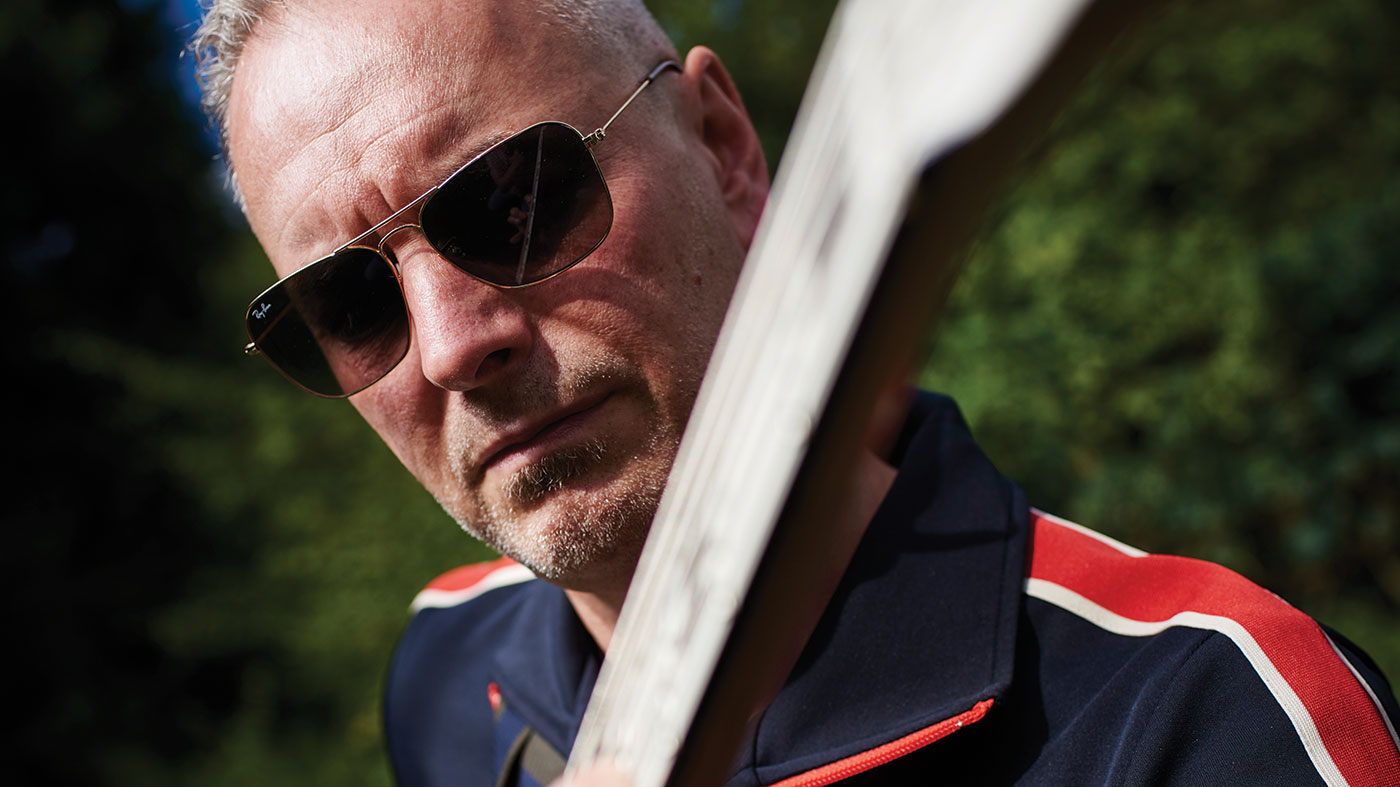
Gigs galore
We like to dig into the details of life as a self-employed musician. How do you get gigs?
“It’s always some kind of personal recommendation - someone getting hold of my number off someone else. I don’t like to decline work, like any self-employed person, but I also think that it’s healthy for my playing to do different things - as long as you don’t burn yourself out. Sometimes I have to be aware of the fact that gigs require a lot more time than just being on the stage. I love learning a set at a soundcheck, but having 30 songs ready to perform precisely for a tour takes a lot of listening time.”
Presumably you don’t always have that time available.
So much of it comes from listening - really listening, out of love for what you hear, not just studying. It has to get under your skin
“Exactly. I’ve done the flying-doctor thing with artists like Robbie Williams and Bryan Ferry, where I’ve gone and done shows without any rehearsal, to cover for their regular bass players. I love that kind of thing. It’s a buzz.”
At what point do you stop accepting gigs because you’ve got enough on your plate?
“I don’t think many musicians actually get to that point these days. The problem with the music industry is that even if you have good relationships with numerous artists, their work rate will fluctuate, and there are also situations when two artists want to tour at the same time, or take a break at the same time, for that matter. I’m looked after well in Jamiroquai, but then you have months without much going on, so I need to stay busy. I like it that way, though. I’ve always played with as many people as I can.”
Do gigs come about because people like the way you mesh with the other musicians in a band?
“That’s one of my strengths, I feel. Believe me, I’m in touch with my weaknesses as well! I like to interact with other musicians, which is probably why I got this gig, and all the previous gigs. So much of it comes from listening - really listening, out of love for what you hear, not just studying something for three hours. It has to get under your skin, without being forced, and then you’ll understand what feels good. I’m still growing as a player, and I still get excited when I hear other people’s playing. It makes me want to break down what they’re doing and work on it myself.”
Which bass players did you admire when you were starting out?
“My first bass hero was Andy Fraser, and I loved Jack Bruce and John Paul Jones. Then I became obsessed with Bernard Edwards, as I was a massive Chic and Sister Sledge fan; those albums were on all the time. I couldn’t believe how clear and perfectly performed the parts were, in comparison to so many other albums. The bass, drums and guitar knit so well together that the groove is undeniable. Equally, I loved AC/DC’s Back In Black.”
Humble beginnings
There’s a lot of synth bass in Jamiroquai. How do you avoid stepping on those frequencies?
“We make sure that we complement each other. In Deeper Underground and Revolution 1993, Matt and I will often play together. I love emulating synth lines on bass guitar, actually. I did a lot of pop and boy-band gigs in the 90s; I played bass synth on a few tracks on an arena tour with 911, and I remember thinking that I would be able to nail it better on the bass guitar.”
Talking of the song Revolution 1993, how do you create that crazy tone?
“I use an octave and an envelope together, and play the line an octave higher than the original part in F - or we play it as a little segue in Deeper Underground, which is in D, so I play it down on the B string. It’s a great line to play. Stuart Zender played it on a Moog on the original recording.”
My first bass was a Hondo Precision copy. It had an awful corkscrew neck that I was told was unfixable
How is your hearing holding up?
“I’ve just had my ears tested, and apparently my hearing is surprisingly good, although there’s some top-end roll-off, mainly in my right ear - because of standing next to drummers! I’ve been lucky because I’ve used in-ears for so long, since one of the first arena tours that ever used them - Take That’s second arena tour in 1992. Unless I’m on a pub gig, I’ll use them all the time.”
How long have you been playing bass?
“Well, it’s been 30 years since I did a day job, which was working for my dad in his hotel up in the Isle Of Man. My mate and I were obsessed with music and we used to visit the local music store every week and buy a single or LP, and the manager - who was a local guitar hero - also looked after the instruments section downstairs. He told us that we should start playing, and we were already doing basic guitar lessons, so he said I should get a bass and then he’d form a band with us.”
What was your first bass?
“A Hondo Precision copy. I started bass lessons and did my first gig with that Hondo. It had an awful corkscrew neck that I was told was unfixable, so I moved on to a Westbury that looked a bit like an Aria guitar. It had quite a good sound, a bit like a Precision, and I used that for a while. Then I got an Aria SB90, which I loved, and two Ibanez Musicians, fretted and fretless.”
What gigs did you play back then?
“I did panto, I played Sunday lunch gigs, I played nightclubs. By the age of 15 I was playing a month of shows in the summer, maybe seven weeks at six nights a week, during the TT races and the Grand Prix. The crowds were around 300 people. My first band was called Tsunami; the next one was called Exile - a reformation of a band that had been previously successful on the Isle Of Man - and then I was in one which played Dr Feelgood-style R&B and reggae, called The Gasp.”
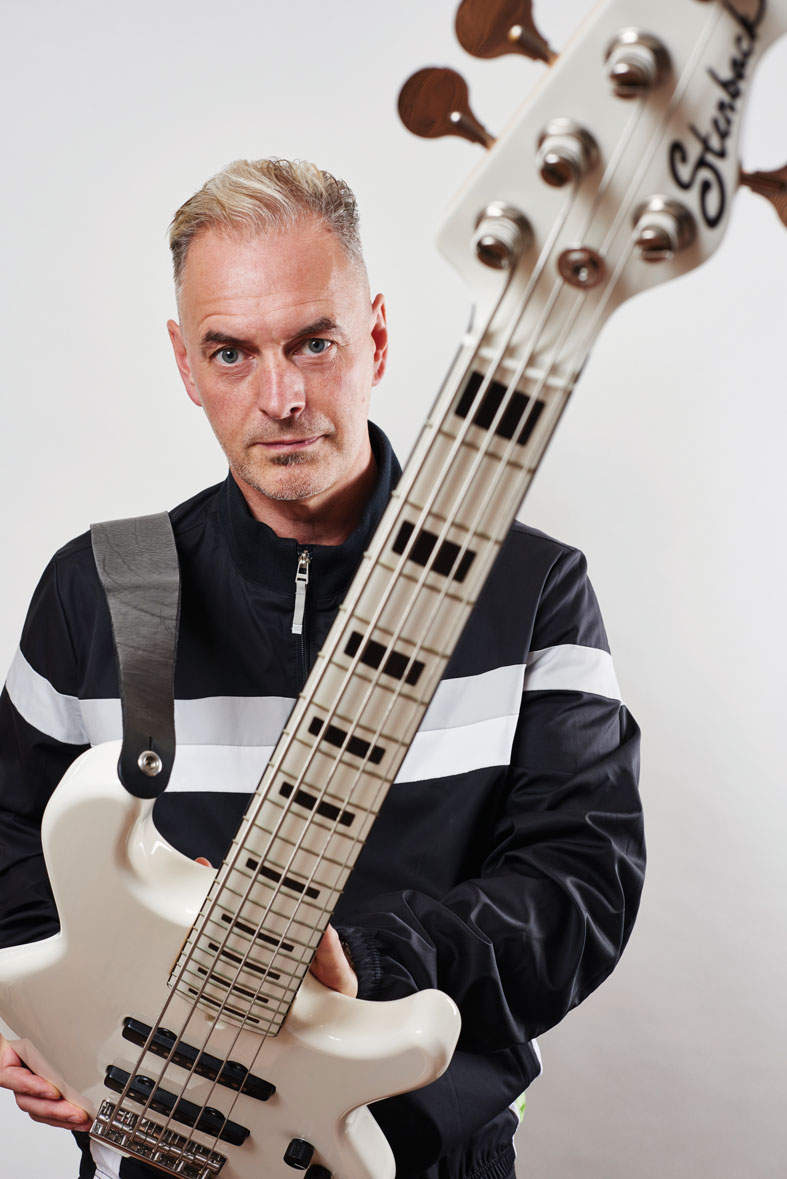
In the pocket
When did music get serious for you?
“When I was in a band called Juice, which played Top 40 covers; we did a lot of Level 42, Hall & Oates and classic soul and funk. We were the house band at Europe’s biggest nightclub, which held 4,000 people; I remember the manager saying to us, ‘If you can keep them on the dancefloor, you’ve got a gig!’”
I assume you had a mullet at this point.
“I had a proper mullet, Duran Duran-style. I even had it dyed a bit red for a while. For my first gig when I was 14, I had a proper Afro. Someone once described it as an explosion in a mattress factory.”
You moved to the mainland in 1987, correct?
You need to be able to do that headnod or foot-stomp while you’re playing, or you’re not in the pocket
“Yes. I ended up in Birmingham with a mate, Roger Inniss, who gave me every dep gig he had, often at short notice. I’d walk into gigs and introduce myself to the band, saying ‘Roger’s not coming but he’s sent me along.’ These were Real Book jazz gigs, Sunday brunches, blues gigs, that kind of thing. That led to me depping for him with Ruby Turner in the late 80s, which I eventually took over from Roger; that led to tours and quite a lot of TV. Bass-wise, I moved to a Warwick five-string Thumb and then Streamers, fretted and fretless, with SWR amps. I also had a Jaydee five-string and two Wals.”
What were the really big career moments for you?
“I depped for Edwin Starr; I did Errol Brown’s tours for three years; and another defining moment was when I met Mike Stevens, who was the MD for Take That and Annie Lennox and a load of other bands. I recorded an EP at his home studio and from there I was recommended for the Take That gig. That led to touring with them from 1992 until 1996, numerous pop tours through the Nineties and world tours with Annie in 2003, 2004 and 2008. My audition for Jamiroquai was over 13 years ago... and every moment has been invaluable.”
Can we have some words of wisdom for our readers about good bass playing?
“I often get asked by students ‘How can I make my groove better?’ and what I always tell them is if music makes you want to nod your head, tap your foot or shake your booty, however ungraceful it is, it’s got a groove. You need to be able to do that head-nod or foot-stomp while you’re playing, or you’re not in the pocket. Do that, and you’re pretty much guaranteed to be there.”
Looking back, what’s been the most important lesson you’ve learned?
“Always keep playing, no matter what the gig. I was always doing gigs, whether it was a European tour or the local pub. That way, you get noticed. All of my gigs have come my way through recommendation; someone has said that I should be on a list of players to try, because they’ve seen me play live. As long as you keep gigging, you won’t go wrong.”
Automaton is out now on Virgin EMI.

